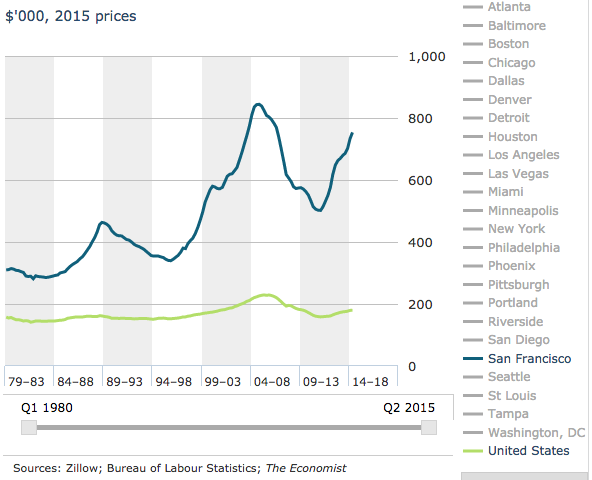A fundamental contradiction lies beneath most of our housing policy debates
At City Observatory, we’ve frequently made the case that promoting homeownership as an investment strategy is a risky proposition. No financial advisor would recommend going into debt in order to put such a massive part of your savings in any other single financial instrument—and one that, as we learned just a few years ago, carries a great deal of risk.
Even worse, that risk isn’t random: It falls most heavily on low-income, black, and Hispanic buyers, who are given worse mortgage terms, and whose neighborhoods are systematically more likely to see low or even falling home values, with devastating effects on the racial wealth gap.
But let’s put all that aside for a moment. What if housing were a low-risk, can’t-miss bet for growing your personal wealth? What would that world look like?
Well, in order for your home to offer you a real profit, its price would need to increase faster than the rate of inflation. Let’s pick something decent, but not too crazy—say, annual increases of 2.5 percent, taking inflation into account. So if you bought a home for $200,000 and sold it ten years later, you’d be looking at a healthy profit of just over $56,000.
Sound good? Well, what if I told you that such a city existed? What if I told you it was in a beautiful natural setting, with hills and views of the ocean? And a booming economy? And lots of organic produce?

Maybe you’ve guessed by now: The wonderland of ever-increasing housing prices is San Francisco. When researcher Eric Fischer went back to construct a database of rental prices there, he found that rents had been growing by about 2.5 percent, net of inflation, for about 60 years. And this Zillow data suggests that San Francisco owner-occupied home prices have been growing by just over 2.5 percent since 1980 as well.
Like I said, over ten years, that gives you a profit of just over 25 percent. But compound interest is an amazing thing, and the longer this consistent wealth-building goes on, the more out of hand housing prices get. In 1980, Zillow’s home price index for San Francisco home prices was about $310,000 (in 2015 dollars). By 2015, after 35 years of averaging 2.5 percent growth, home prices were over $750,000.

Now, if all you cared about were wealth building, this would be fantastic news. The system works! (Although actually even this rosy scenario is missing some wrinkles: San Francisco real estate prices did suffer enormously, if briefly, during the late-2000s crash, and if you bought in the mid-2000s and had to sell in, say, 2010, you would have taken a massive loss.)
But this sort of wealth building is predicated on a never-ending stream of new people who are willing and able to pay current home owners increasingly absurd amounts of money for their homes. It is, in other words, a massive up-front transfer of wealth from younger people to older people, on the implicit promise that when those young people become old, there will be new young people willing to give them even more money. And of course, as prices rise, the only young people able to buy into this ponzi scheme are quite well-to-do themselves. And because we’re not talking about stocks, but homes, “buying into this ponzi scheme” means “able to live in San Francisco.”
In other words, possibly the only thing worse than a world in which homeownership doesn’t work as a wealth-building tool is a world in which it does work as a wealth-building tool.
This also means that the two stated pillars of American housing policy—homeownership as wealth-building and housing affordability—are fundamentally at odds. Mostly, American housing policy resolves this contradiction by quietly deciding that it really doesn’t care that much about affordability after all. While funds for low-income subsidized housing languish, much larger pots of money are set aside for promoting homeownership through subsidies like the mortgage interest deduction and capital gains exemption, most of which goes to upper-middle- or upper-class households.
But even markets with large amounts of affordable housing demonstrate the contradiction. Since at least the second half of the 20th century, the vast majority of actually affordable housing has been created via “filtering”: that is, the falling relative prices of market-rate housing as it ages, or its neighborhood loses social status, often as a result of racial changes. Low-income affordability, where it does exist, is predicated on large portions of the housing market acting as terrible investments.
And to the extent that low-income people do find a subsidized, price-fixed housing unit to live in, that means that they won’t be building any wealth, even as their richer, market-housing-dwelling neighbors do, increasing wealth inequality.
Even the community land trust, which seems to be a way of squaring the wealth-building/affordability circle, ultimately fails. Community land trusts typically provide subsidized or reduced price ownership opportunities to initial buyers, and assure longer term affordability by limiting the resale price of the home. In other words, CLT-financed homes remain affordable only because they restrict how much wealth building the initial owners are allowed to capture. The result is that CLT-financed homes only attract those who couldn’t otherwise purchase a home—which means that the lower-income people in CLTs will be building wealth more slowly than higher-income people in market-rate housing, a fundamentally inequality-increasing situation.
We say we want housing to be cheap and we want home ownership to be a great financial investment. Until we realize that these two objectives are mutually exclusive, we’ll continue to be frustrated by failed and oftentimes counterproductive housing policies.
Editors note: This City Observatory commentary was authored by Daniel Kay Hertz. The version published on October 26 contained an incorrect reference to the author. We regret the error.

